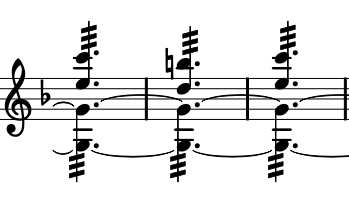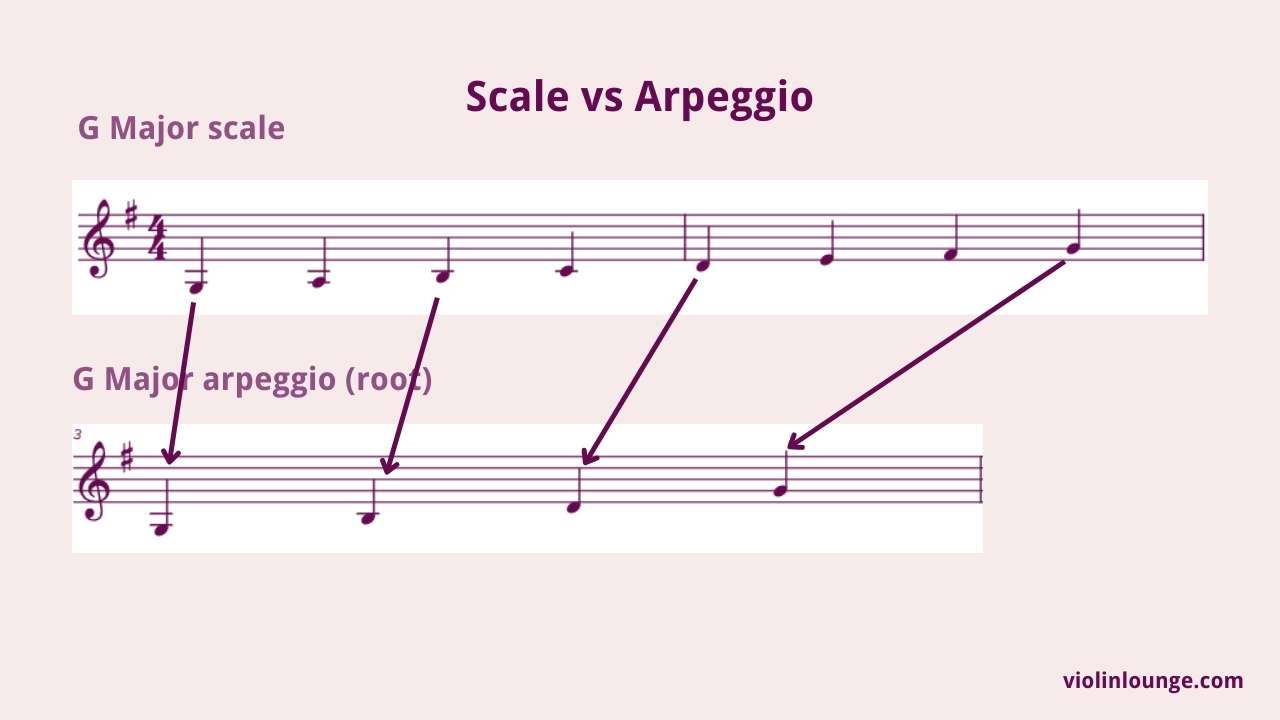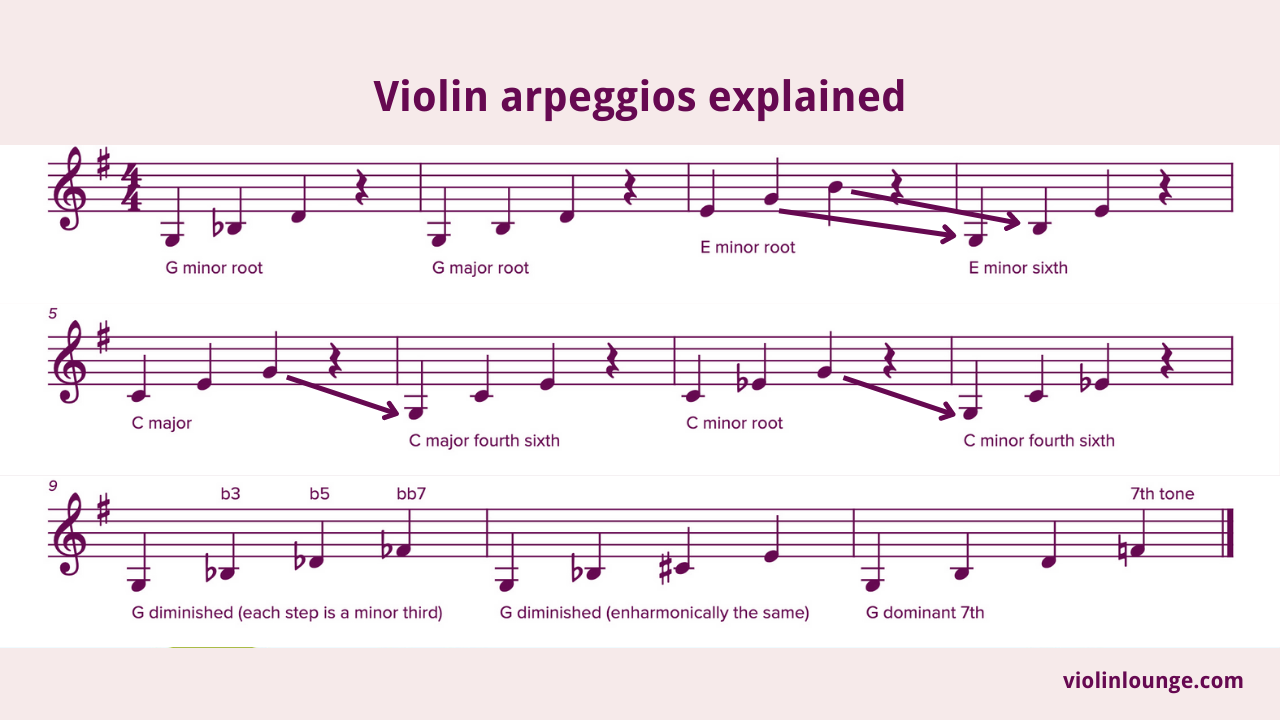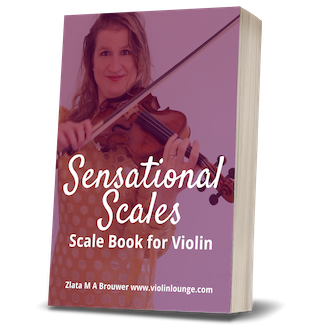What are Violin Arpeggios? (and why should you practice them)
Scales and arpeggios are great to improve your violin technique
Whether you just started playing or you are practicing violin arpeggios for years already, in this article you’ll learn how arpeggios are structured and why it’s so important to practice them.
Introducing Violin Arpeggios
If you have taken a serious interest in violin, whether on your own or with a teacher, you have probably heard many times by now, “You have to practice scales!” This is true: scales lay the groundwork for all your future pieces and help you understand where all the notes are on the fingerboard. If you practice them consistently and in different patterns, your playing will become more fluent and confident.
Here’s the catch though: only doing scales is not enough. Arpeggios also form a major part of violin repertoire.
What does that mean exactly? Arpeggios are broken chords that use the chord tones in a scale. In other words, imagine a C major scale: C, D, E, F, G, A, B, C. Say you want to play a C major arpeggio. The C major triad is C, E, G, so a one-octave C major arpeggio would be C, E, G, C. (In exercises arpeggios usually end on the tonic, but remember in music there will often be incomplete arpeggios as well.)
On the violin, arpeggios can go for one, two, three, or sometimes four octaves.
Like scales, you should use arpeggios for practicing multiple things, including bow technique. We will go into this more in a moment when we talk about how to practice arpeggios.
Why should you practice arpeggios on the violin?
Perhaps you feel you already have enough to practice. Maybe just playing scales is so helpful you don’t see a reason to add arpeggios. I guarantee that doing both will give you the fastest improvement. Arpeggios teach you finger patterns that scales don’t because in arpeggios you have to skip notes. Arpeggios also help with jump shifts and silently finding the right notes. You will most definitely encounter arpeggios in any level of repertoire you are learning, so why not begin working on them now?
Examples of arpeggios is violin music
For example here are three excerpts from the Mendelssohn, Vivaldi, and Kabalevsky concertos. All the arpeggios here are very fast and performed best when they are practiced out of context first.
How to Practice Violin Arpeggios
Practicing violin arpeggios to improve intonation (playing in tune)
As mentioned previously, you can practice arpeggios many different ways. Initially, just play each note separately to get the intonation and shifting if there is any. To practice the jump shifts in arpeggios, always shift keeping the old finger down. Slide the finger along the string audibly from the lower pitch to the higher pitch to make sure you are hitting it correctly before trying to do it silently. Even in silent shifts, the finger still stays on the string but with less pressure so a sound is not produced. If you take your finger completely off the string while shifting, there is no guarantee you will correctly hit the next note. Another common pitfall is breaking the contact of the bow and the string while shifting. People do this as a way to “hide” the shift, but it actually just lessens the tone quality of the arpeggio. Similarly, it is important to use more pressure at the tip so your arpeggio does not fade away at the top.
Practicing violin arpeggios in martelé bow strokes
Practicing in martelé is a good way develop strong tone quality in every part of the bow. Practice with three, six, and nine martele per bow. Similarly, practicing in rhythms helps coordinate left hand speed, bow action, and shifting. The rhythm combinations you can choose are almost endless, but the most common are short-long and long-short. Make sure on the short notes your bow catches the string with a little bit of a bite so you are always getting the best sound.
Practicing violin arpeggios for bowing technique
Arpeggios also help us learn a wide variety of bowing techniques. If you are new to arpeggios, start with just separate bows in martelé and detaché first. Then slur together three, six, nine, etc. Some teachers ask their students to get to up and down twice in one bow. The more notes you have per slur, the faster your left hand has to be and the slower your bow speed should be.
When you can execute slurred legato arpeggios with good intonation and solid tone, consider trying some of the following: slurred rhythms, upbow staccato, little detaché’s at the frog (great for flexibility of the right hand fingers), and collé.
The left hand can get pretty complicated during arpeggios (all those shifts and string crossings!) which can distract from getting a focused sound with the bow. It is always better to play arpeggios slowly with a strong, beautiful tone before trying to go faster.
How Violin Arpeggios are Structured
As we discussed previously, all arpeggios are simply broken chords.
 In a chord the notes are placed above each other in the sheet music and they are played at the same time. In an arpeggio the notes are played one by one starting on the lowest note. Sometimes in sheet music arpeggios are written like chords, but with a vertical wave next to them or with a tremolo notation like in the picture.
In a chord the notes are placed above each other in the sheet music and they are played at the same time. In an arpeggio the notes are played one by one starting on the lowest note. Sometimes in sheet music arpeggios are written like chords, but with a vertical wave next to them or with a tremolo notation like in the picture.
This means that no matter what scale you are playing, if you don’t have arpeggio sheet music you can always figure out what the arpeggio should be if you know the chord. Most arpeggios are based on the major or minor scales, but advanced books will also include diminished arpeggios and seventh chords, which helps with learning different finger placements.
A triad is a three-note chord built on the 1st, 3rd, and 5th degrees of its parent scale. For example, the easiest scale to play on violin is A Major: A, B, C#, D, E, F#, G#, A. What are the 1st, 3rd, and 5th scale degrees? A, C#, E. The full arpeggio would add the high A at the top. This way of structuring arpeggios is the same no matter how many octaves you are playing.

A Side Note on Minor Arpeggios
If you have already been playing scales for a while, you may know that there are three types of minor scale: natural, harmonic, and melodic. You might be wondering, “how does this affect the arpeggios? Do I need to learn three different kinds?” No, actually, you don’t! Harmonic and melodic minor alter the sixth and seventh scale degrees. Since arpeggios use scale degrees 1, 3, and 5, the minor arpeggio will be the same for every type of minor scale.
Most common arpeggios to practice on the violin
The most common arpeggios on the violin go with the most common scales: G, A, D, and C. G Major is the easiest to start with because it starts on the lowest open string. For advanced violinists, there is a whole cycle of arpeggios for each given key. This is demonstrated in the Carl Flesh scale system. The cycle of arpeggios for G Major is: G Minor, G Major, E Minor, C Major, C Minor, G diminished, and G dominant seventh. Why do this whole cycle instead of just G Major? Because it moves through multiple related finger patterns and develops left hand flexibility faster. The E Minor, C Major, and C Minor arpeggios are inverted to fit better with G Major. Inverting a chord means putting a note other than the root, such as the third or fifth, on the bottom of the chord. Here’s an overview of how the G major arpeggios are structured:

Books for Learning Scales and Arpeggios
I’ve linked up the most popular violin scale books below, so you can easily buy the book of your choice and start practicing violin arpeggios.
There are SO many systems out there for learning arpeggios, especially at the beginner level. If you use a system like Suzuki and Sassmanshaus, you will learn scales in a very particular order connected to the pieces you learn. This is better than trying to learn them all at once, which can be overwhelming and mess up your intonation if you attempt them all before solidifying a few.
For advancing beginners and intermediate players, Hrimaly, Fischer, and Sevcik are good choices. Excellent new-comers are Serrano scales and Barber. A free option is my book Sensational Scales which you can download right here.
The two major scale systems used by advanced violinists are Flesch and Galamian. These are very extensive systems that incorporate scales, arpeggio patterns, chromatic scales, thirds, sixths, octaves, harmonics, and everything in between.
Do you practice violin arpeggios?
Let me know what book you’re using in the comments!
FREE Violin Scale Book
Sensational Scales is a 85 page violin scale book that goes from simple beginner scales with finger charts all the way to all three octave scales and arpeggios


Thanks, Zlata, for sharing this tutorial. I’m impressed by Hilary’s performance. I have trouble remembering one or two bars, and her… she has memorized the whole piece, without reading a single sheet. I’m jealous. 🙂
You’re welcome, Roger!
Thank you Zalta for today’s video on arpeggios! I have the Flesch scale book which is pretty overwhelming. I just purchased the beginner and advanced Barbara Barber scale books. I am just now learning that there are more than just major and minor arpeggios! The inversions and dominant 7ths are a bit confusing. More videos on this topic would be wonderful!
Wonderful! Yes, the Barber books are great and an excellent addition to the (indeed intimidating) Flesch. Will do more on arpeggios :).